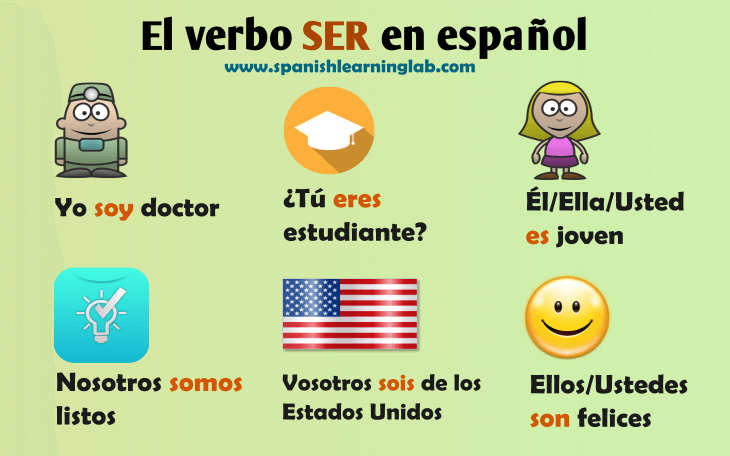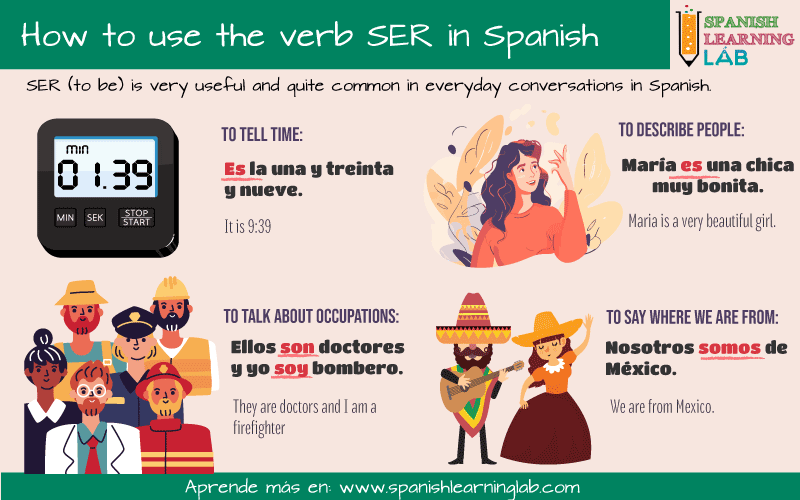As we have seen in previous lessons, the verb to be in Spanish has two forms: SER and ESTAR. Both of them are irregular verbs. In this lesson, we will learn to conjugate SER for all personal pronouns, and more importantly, how to make sentences using SER in Spanish to talk about different situations in the present tense. This lesson includes several nice resources for you to see the verb in use and practice activities too.
Introductory video: The verbs SER and ESTAR in Spanish
We will begin the lesson with a short video explaining the basics about both SER and ESTAR. The video includes several examples of situations in which we might use them. This video is also part of our lesson about ESTAR, so if you have studied that lesson before, then many things will make more sense now. Pay attention to the examples in the video and the main differences between both verbs.
How to conjugate SER in Spanish in the present tense
As we mentioned before, SER is an irregular verb, so it will change its form for most pronouns in the present tense. The chart below shows all the conjugations for the verb SER (to be) for the different pronouns in the present indicative:
| Subject | Verb SER | Translation |
| Yo | soy | I am |
| Tú | eres | You are |
| Vos | sos | You are (informal) |
| Él/ella/usted | es | He/she/you (formal) are |
| Nosotros | somos | We are |
| Vosotros | sois | You are (used in Spain) |
| Ellos | son | They are |
As you can see in the chart, the verb SER looks entirely different to its original form depending on the subject it makes reference to. Given that it is an irregular verb, you must memorize its forms for the different pronouns, and then add a complement to make simple sentences like the ones shown in this picture:

How to make sentences using SER in Spanish: explanations + audio
Using SER in Spanish to describe people and other things
SER is normally used in many topics including physical descriptions, to describe houses, to talk about clothes, to say what the weather is like and many other purposes. Most of the time, sentences with SER will use the form ES to describe a single object and SON for several. The main difference between both SER and ESTAR is that SER describes things that will not change easily over time or that never change at all wheras ESTAR describes temporary states, for example:
- Él es inteligente. (He is intelligent.)
- Él está enfermo. (He is sick)
- La tierra es redonda. (The earth is round)
- El café está caliente. (The coffee is hot)
As you can see in the examples, SER is used with adjectives to describe something. ESTAR has the same use when talking about conditions that will change soon, for example: “El clima está frío”. This last example means that the weather is cold today, but maybe it has been warm in the past few days. Here are some sentences using SER for descriptions in Spanish
|
Ella es alta y bonita. (SER for physical appearance)
She is tall and beautiful.
|
|
Su vestido es rojo. (SER for colors)
Her dress is red.
|
|
La luna es un satélite.
The moon is a satellite
|
|
El piano y la guitarra son instrumentos musicales.
The piano and guitar are musical instruments
|
|
Ellos son amigables. (SER for personality traits)
They are friendly
|
Using SER in Spanish to say where you are from, the time and your job
SER is also used to talk about countries and nationalities, “países y nacionalidades”, to say your country of origin, for telling time using “ES and SON + the hour” and also for talking about your occupation. Here are some more sentences with SER in Spanish for these purposes.

|
¿Cómo es la casa? – La casa es lujosa y espaciosa. Está limpia.
What does the house look like? – The house is luxurious and spacious. It’s clean.
|
|
¿De dónde eres? – Yo soy de Brasil, pero estoy trabajando en Paraguay.
Where are you from? – I’m from Brazil, but I’m working in Paraguay.
|
|
¿Qué hora es? – Es la 1 de la tarde ¿Ya estamos cerca?
What time is it? – It is the 1 pm. Are we close?
|
|
¿Qué haces? – Soy maestro. Es un trabajo interesante, pero hoy estoy cansado.
What are you doing? – I am a teacher. It is an interesting job, but I’m tired today.
|
Related Spanish Worksheets:
- The verb SER in Spanish
- The verb ESTAR in Spanish
- Common Irregular Verbs in Spanish
- Conjugating Irregular Verbs in Spanish
- Irregular Verbs in Spanish in the Present Tense
